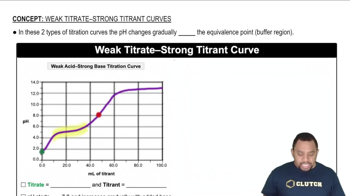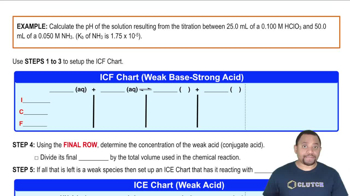You have to prepare a pH = 5.00 buffer, and you have the following 0.10 M solutions available: HCOOH, HCOONa, CH3COOH, CH3COONa, HCN, and NaCN. Which solutions would you use?
Compare the titration of a strong, monoprotic acid with a strong base to the titration of a weak, monoprotic acid with a strong base. Assume the strong and weak acid solutions initially have the same concentrations. Indicate whether the following statements are true or false: (b) The pH at the beginning of the titration is lower for the weak acid than the strong acid. (c) The pH at the equivalence point is 7 no matter which acid is titrated.
 Verified step by step guidance
Verified step by step guidanceKey Concepts
Titration Basics

Strong vs. Weak Acids

Equivalence Point and pH

You have to prepare a pH = 5.00 buffer, and you have the following 0.10 M solutions available: HCOOH, HCOONa, CH3COOH, CH3COONa, HCN, and NaCN. How many milliliters of each solution would you use to make approximately 1 L of the buffer?
The accompanying graph shows the titration curves for two monoprotic acids. (d) Estimate the pKa of the weak acid.
Compare the titration of a strong, monoprotic acid with a strong base to the titration of a weak, monoprotic acid with a strong base. Assume the strong and weak acid solutions initially have the same concentrations. Indicate whether the following statements are true or false. (a) More base is required to reach the equivalence point for the strong acid than the weak acid.
The samples of nitric and acetic acids shown here are both titrated with a 0.100 M solution of NaOH(aq).
Determine whether each of the following statements concerning these titrations is true or false. (a) A larger volume of NaOH1aq2 is needed to reach the equivalence point in the titration of HNO3.
Determine whether each of the following statements concerning the titrations in Problem 17.35 is true or false. (a) The pH at the beginning of the two titrations will be the same.
